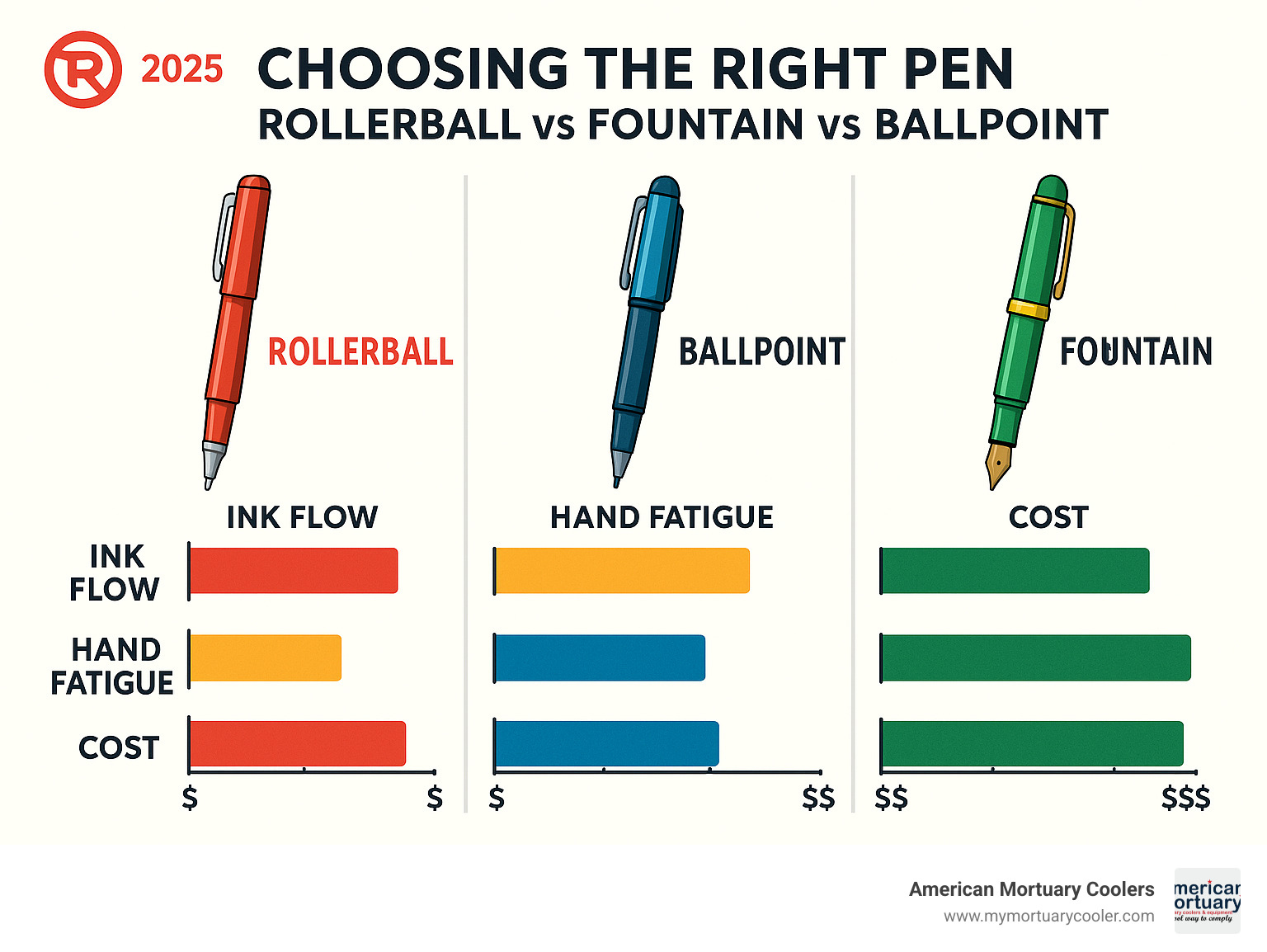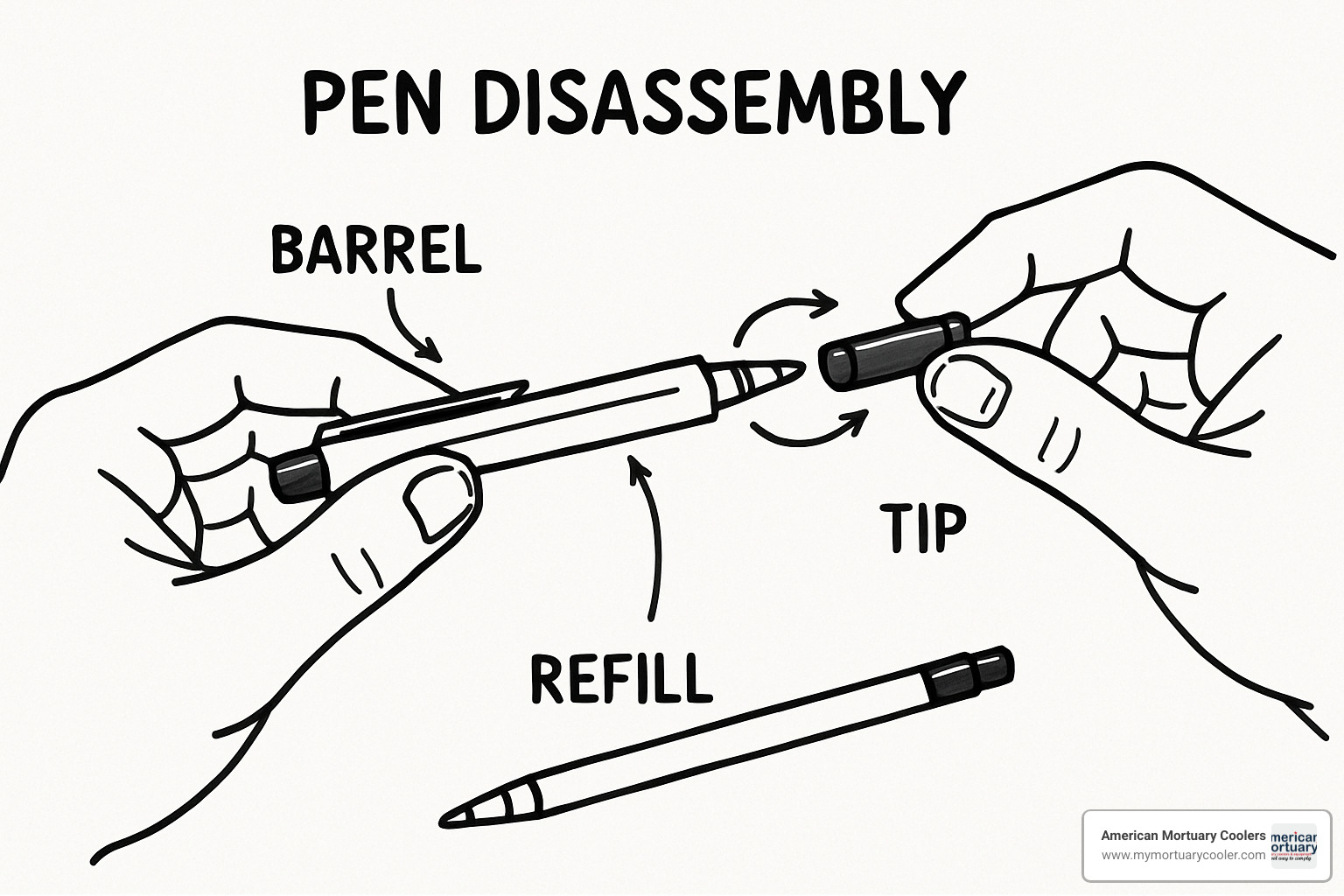Understanding Roller Ball: From Writing Tools to Pop Culture Icons
Roller ball products span an incredible range - from the smooth-writing pens in your desk drawer to the dystopian sport that captivated movie audiences for decades. Whether you're searching for the perfect writing instrument, curious about the cult classic films, or exploring industrial applications, roller ball technology touches more aspects of daily life than most people realize.
Quick Roller Ball Overview:
- Pens: Use liquid or gel ink with a rolling ball tip for smooth writing
- Films: 1975 sci-fi classic about corporate control vs. 2002 action remake
- Sports: Fictional violent game that inspired real roller derby and video games
- Industrial: Ball-bearing systems used in mortuary equipment and storage racks
- History: Patented in 1888, popularized in 1970s, culturally significant through films
The story of roller ball begins with a simple 1888 patent by John J. Loud, but it evolved into something much bigger. From breakthrough ink technologies that revolutionized how we write, to Norman Jewison's 1975 film that warned about corporate dystopias, roller ball became both a practical tool and a cultural phenomenon.
The appeal is clear - roller ball pens offer the smoothness of fountain pens with the convenience of ballpoints. The films explored timeless themes of individuality versus control. And the industrial applications provide reliable, smooth operation in everything from mortuary storage systems to manufacturing equipment.
As American Mortuary Coolers with years of experience in mortuary equipment, we've seen how roller ball bearing systems improve the reliability and smooth operation of storage racks and cooling units. The same principles that make roller ball pens glide effortlessly across paper also ensure mortuary equipment operates quietly and efficiently for funeral home professionals.

Explore more about *roller ball *:
From Patented Pens to Pop-Culture Phenomenon: The History of Roller Ball
The roller ball story starts way back in 1888, when John J. Loud had a brilliant idea. He wanted to create a writing tool that could "write on rough surfaces such as wood, coarse wrapping-paper, and other articles." Like many inventors ahead of their time, Loud's patent was clever - but the world wasn't quite ready for it yet.
It took nearly 60 years for technology to catch up with his vision. In 1945, after World War II brought advances in manufacturing, the first commercial roller ball pens finally hit the market. The challenge had always been tricky - how do you create a ball mechanism precise enough to control liquid ink without making a mess?
The 1970s became the golden age for roller ball technology. Japanese company Ohto had pioneered water-based ink ballpoint pens in the 1960s, and Pilot introduced their game-changing Hi-Tecpoint with a needle tip in 1977. These weren't just better pens - they were writing instruments that combined the smoothness of fountain pens with everyday convenience.
But something else happened in 1975 that would make "roller ball" famous for entirely different reasons. Director Norman Jewison adapted William Harrison's short story "Roller Ball Murder" into a dystopian film called "Rollerball."
The movie imagined a dark future where giant corporations had replaced governments. In this world, a violent sport called Rollerball served as both entertainment and social control. James Caan played Jonathan E., a star player who becomes a symbol of individual resistance against corporate conformity.
The film struck a nerve with 1970s audiences who were watching real corporations grow more powerful every day. Made for just $5-6 million, the original "Rollerball" earned about $30 million at the box office and scored a solid 67% on Rotten Tomatoes.
| Milestone | Pens | Movies |
|---|---|---|
| 1888 | John J. Loud patents first roller ball concept | - |
| 1945 | First commercial roller ball pens launched | - |
| 1960s | Ohto develops water-based ink ballpoint | - |
| 1975 | Pilot and other brands expand market | "Rollerball" film released |
| 1977 | Pilot Hi-Tecpoint needle tip introduced | - |
| 2002 | Capless roller ball refills developed | "Rollerball" remake flops |
Early Inventions & Ink Breakthroughs in Roller Ball Technology
John J. Loud had the right idea, but 1888 technology just couldn't deliver. His original roller ball design featured a small rotating ball that would pick up ink from a reservoir and roll it onto paper. Simple concept, nightmare execution.
The main problem? Early roller ball pens leaked everywhere. The thin, low-viscosity ink needed for smooth writing was nearly impossible to contain with 19th-century manufacturing.
Three major breakthroughs finally solved these problems. Chrome ball technology arrived in 1949 when Ohto created the world's first ballpoint pen with a chrome ball. Water-based ink formulations replaced the thick oils used in ballpoint pens, flowing freely while staying controlled. And tungsten-carbide tips, introduced in the late 1950s, provided the incredible hardness and precision needed for reliable operation.
The Birth of the Fictional Sport "Roller Ball"
While engineers perfected pen technology, science fiction writer William Harrison was dreaming up something much darker. His 1973 short story "Roller Ball Murder" imagined a violent sport that combined roller derby, motorcycle racing, and gladiatorial combat.
But Harrison's fictional Rollerball wasn't really about sports. In his story, the game served as the ultimate form of social control in a world run by corporations instead of governments. Players would compete brutally while the real message was demonstrating "the futility of individual effort."
Norman Jewison immediately saw the story's potential as social commentary. The production team built elaborate arena sequences, filming mainly in Munich's Rudi-Sedlmayer-Halle for its nearly circular shape. They designed the arena like a cross between a roulette wheel and pinball machine - circular, enclosed, with players bouncing off walls in chaotic patterns.
Roller Ball on Screen: 1975 Classic vs 2002 Remake
The tale of two roller ball movies perfectly shows how the same idea can go in completely different directions. The original 1975 film used the violent sport to make people think about corporate power and individual freedom. The 2002 remake? Well, it mostly just wanted to show off flashy action scenes.
Norman Jewison's original film starred James Caan as Jonathan E., a roller ball champion who becomes too popular for his own good. The corporate bosses want him to retire, but he refuses to go quietly. John Houseman was absolutely chilling as the cold corporate executive trying to force Jonathan out of the game.
What made the original special was its restraint. Jewison used classical music - Bach, Albinoni, and Shostakovich - to create this eerie contrast with the brutal sport. Imagine watching gladiators fight while listening to a symphony orchestra. It was unsettling in the best possible way.
The 2002 remake took a completely different approach. Director John McTiernan cast Chris Klein and Rebecca Romijn in what became more of an extreme sports movie than a thoughtful dystopian thriller.
The box office numbers tell the whole story:
The 1975 original cost about $5-6 million to make and earned $30 million at the box office. Critics gave it a solid 67% on Rotten Tomatoes, and it has maintained a 6.5/10 rating on IMDb from over 31,000 viewers.
The 2002 remake had a massive $70 million budget but only made $25.9 million worldwide. Critics absolutely demolished it with a brutal 3% rating on Rotten Tomatoes. On IMDb, it scored just 3.1/10 from 30,000 users.
The remake's failure was so complete that it swept several categories at the 2002 Stinkers Bad Movie Awards. You can read more about the remake's troubled production in the American Film Institute's detailed analysis.

Why the 1975 "Roller Ball" Still Resonates
The original roller ball movie feels more relevant today than when it first came out. Its warnings about corporate power controlling society through entertainment seem almost prophetic in our age of social media algorithms and data collection.
Jonathan E.'s fight against the corporate executives represents something timeless - the struggle between individual achievement and systemic control. The film's most powerful moments aren't the violent arena scenes, but the quiet conversations where Jonathan starts questioning everything around him.
His interactions with the supercomputer "Zero" are particularly haunting. This machine has replaced traditional libraries and human knowledge, giving only fragments of information when asked direct questions. Sound familiar in our age of search engines and AI?
The classical music soundtrack deserves special recognition. André Previn's score, performed by the London Symphony Orchestra, creates this deeply unsettling mood. Hearing Bach's Toccata and Fugue while watching brutal violence suggests a world where even beautiful art has been twisted for corporate purposes.
How the 2002 "Roller Ball" Missed the Goal
The 2002 remake's problems started early and just kept getting worse. Test screenings in Las Vegas went so badly that audiences actually jeered at the screen. MGM had to delay the release from summer 2001 to February 2002 for extensive reshoots.
Director John McTiernan faced constant studio interference throughout production. Executive notes complained that content was "too Asian," leading to major cuts and changes. The original score by Brian Transeau was scrapped because it sounded "too Arabic."
The biggest mistake was changing the roller ball sport itself. The original featured a game that viewers could understand and follow. The remake created what one critic called "a sport too complicated to explain," with ramps, tunnels, and random explosions that prioritized flashy visuals over making sense.
The shift from R-rated social commentary to PG-13 action spectacle fundamentally changed everything. Where the original asked big questions about society and corporate power, the remake just wanted to show off motorcycle stunts and special effects.
Roger Ebert captured the critical consensus perfectly, calling it "an incoherent mess, a jumble of footage in search of plot, meaning, rhythm and sense."
Real-World Roller Ball Products & Applications
Beyond the silver screen, roller ball technology has found practical applications across numerous industries. The fundamental principle - using a rotating ball to transfer material smoothly and controllably - proves useful far beyond writing instruments.
In the pen industry, roller ball technology has evolved significantly since those early leaky prototypes. Modern roller ball pens use sophisticated ink formulations and precision-manufactured tips to deliver consistent performance. The key innovation is the balance between ink viscosity and tip design - thin enough to flow smoothly, controlled enough to prevent leaks.
Today's roller ball pens fall into several categories:
- Traditional liquid ink: Water-based formulations that provide the smoothest writing experience
- Gel ink: Hybrid formulations that combine smooth flow with quick-drying properties
- Capless designs: Engineering breakthroughs like the Schmidt P8126 refill that prevent drying without requiring a cap
At American Mortuary Coolers, we've seen how roller ball bearing systems improve mortuary equipment reliability. Our custom storage racks and cooling units incorporate roller bearing technology to ensure smooth, quiet operation - critical factors in funeral home environments where noise and mechanical reliability matter enormously.
The same principles that make roller ball pens glide effortlessly also ensure our mortuary stretchers and storage systems operate smoothly under heavy loads. More info about roller storage racks shows how these systems improve efficiency and reduce physical strain on funeral home staff.
Choosing the Right Pen: Rollerball vs Fountain vs Ballpoint
Understanding the differences between pen types helps you select the right tool for your needs. Each design serves different purposes and writing styles.
Roller Ball Pens:
- Use liquid or gel-based ink for smooth writing
- Require little pressure, reducing hand fatigue
- Produce bold, saturated lines
- Need caps to prevent drying
- Refill more frequently than ballpoints
- Price range: $1 to $300+
Ballpoint Pens:
- Use thick, oil-based ink
- Require more writing pressure
- Last longer between refills
- Don't dry out when uncapped
- More affordable and practical for everyday use
Fountain Pens:
- Use water-based ink with a nib system
- Provide the smoothest writing experience
- Allow for line variation and calligraphy
- Require more maintenance and care
- Higher initial cost but potentially lower long-term costs
For most users, roller ball pens offer the best compromise - smoother than ballpoints, more convenient than fountain pens. The 0.7mm tip width works well for general writing, though options range from 0.2mm for detailed work to 1.5mm for bold signatures.
Left-handed writers should note that roller ball ink takes longer to dry than ballpoint ink, potentially causing smudging. Gel-based formulations dry faster than traditional liquid inks, making them a better choice for southpaws.

Extreme Sports & Games Inspired by Roller Ball
The fictional sport of Rollerball inspired real-world activities and games that capture elements of its high-speed, contact-heavy action. While we'll never see the exact corporate dystopian version from the films, several sports and games draw clear inspiration from the concept.
Roller Derby represents the closest real-world equivalent to Rollerball. Teams of skaters race around an oval track, with designated players trying to lap opponents while blockers use physical contact to prevent scoring. The sport experienced a major revival in the 2000s, with leagues forming across the United States and internationally.
WhirlyBall combines elements of basketball and bumper cars, with players in motorized vehicles trying to score goals with a ball. While less violent than fictional Rollerball, it captures the combination of vehicles, balls, and competitive chaos that made the film sport compelling.
Video games have repeatedly tried to capture the Rollerball experience:
- Speedball (1988) and Speedball 2 (1990) created futuristic sports games with obvious Rollerball influences
- Rollerdrome (2022) combines roller skating with third-person shooting in arenas clearly inspired by the films
- Various mobile and console games have attempted to recreate the sport with mixed success
The 2002 remake's attempt to connect with extreme sports culture included cameos from pop star Pink, members of Slipknot, and wrestling personality Shane McMahon. While these appearances didn't save the film, they highlighted the ongoing appeal of combining traditional sports with high-speed, high-contact elements.

Interestingly, even traditional sports have adopted roller ball elements. Some muzzleloader enthusiasts use devices like the "vortex ball roller" to create dimpled lead balls that theoretically improve accuracy by reducing air resistance - applying golf ball aerodynamics to 18th-century firearms technology.
Care, Maintenance & Safety Tips for Your Roller Ball Investments
Taking care of your roller ball equipment - whether it's a treasured writing instrument or industrial mortuary equipment - doesn't have to be complicated. A little attention goes a long way toward keeping everything running smoothly for years to come.
Storage makes all the difference with roller ball pens. Keep them upright when possible to prevent those annoying leaks that seem to happen at the worst possible moments. The liquid ink in these pens loves gravity, and storing them tip-down can cause messy surprises in your shirt pocket.
Always cap your pens when you're done writing. Unlike ballpoint pens that can sit uncapped for weeks, roller ball ink dries quickly when exposed to air. We've all grabbed a favorite pen only to find it's turned into an expensive paperweight because the tip dried out.
Air travel presents special challenges for roller ball pens. Cabin pressure changes can turn even the best pen into a leaky mess. Your safest bet is to either empty the pen completely before flying or install a fresh refill right before your trip. A protective case helps too - those delicate tips don't appreciate being bounced around in luggage.
Cleaning your roller ball pens is straightforward but important. A soft cloth with mild soap handles the exterior beautifully. For those neat silver-barreled pens, appropriate silver polish keeps them looking professional. If the tip gets clogged (and it happens to everyone), try rolling it gently on blank paper first. Sometimes a little warm water helps too, but never force anything.
Here's something most people don't know: most branded ceramic roller ball refills are made in the same German facilities. This means a Parker refill often works perfectly in a Cross pen. You can mix premium refills with more affordable pen bodies and get excellent results.
Standard ceramic refills like the Schmidt 888 fit most capped roller ball pens. Short capless refills work in twist-action designs, while long capless refills fit specific models with longer barrels.

Industrial roller ball systems need different care, but the principles remain simple. At American Mortuary Coolers, we've learned that regular lubrication keeps bearing systems operating smoothly and quietly - absolutely crucial in funeral home environments where unexpected noise can be disruptive during services.
Inspection matters too. Check roller tracks regularly for debris or damage that could affect performance. A small piece of lint or dust can cause surprisingly big problems over time. Prompt replacement of worn rollers prevents damage to expensive storage racks or stretcher systems.
The same attention to detail that keeps a fine writing instrument working perfectly also ensures mortuary equipment operates reliably when funeral directors need it most.
Frequently Asked Questions about Roller Ball
People often have questions about roller ball technology, whether they're curious about the fictional sport from the movies or dealing with practical pen problems. Let's tackle the most common questions we hear.
What are the official rules of the fictional Rollerball sport?
The beauty of the original 1975 Rollerball sport was its deliberate simplicity. Two teams competed in a circular arena - some players on roller skates, others on motorcycles. The goal was straightforward: get the steel ball into the opposing team's goal.
What made the sport truly dystopian wasn't complexity, but the gradual elimination of rules. The corporate executives kept removing penalties and time limits to increase violence. This wasn't about creating a playable game - it was about demonstrating how individuals become meaningless against the system.
Norman Jewison designed the sport as a metaphor rather than actual entertainment. That's exactly why the 2002 remake struggled so badly when it tried to create "realistic" rules with ramps, tunnels, and explosions. Critics called it "a sport too complicated to explain," and they were right. Sometimes simple works better than elaborate.
The original's genius lay in its restraint. You could understand the basic concept immediately, which let the film focus on its real themes about corporate control and individual resistance.
Do rollerball pens leak on airplanes?
Unfortunately, yes - roller ball pens are notorious for leaking during flights. The cabin pressure changes mess with the delicate balance between the liquid ink and the pen's internal mechanisms. It's one of those frustrating travel realities that frequent flyers learn the hard way.
The problem comes down to physics. Roller ball pens use thin, liquid ink that flows easily - which is exactly what makes them write so smoothly on the ground. But at 35,000 feet, pressure changes can force that ink right out through the tip or even through tiny gaps in the pen body.
Here's what actually works to prevent leaks: empty your pen completely before flying or install a brand-new refill. Store it upright in your carry-on, keep it capped throughout the flight, and consider investing in a proper leak-proof pen case.
Many business travelers keep a separate ballpoint pen just for flights, then switch back to their favorite roller ball once they land. It's not ideal, but it beats finding ink all over your important documents at 30,000 feet.
Why did the 2002 remake perform poorly at the box office?
The 2002 "Rollerball" remake is a perfect case study in how not to update a classic. With a $70 million budget - more than ten times what the original cost - it managed to earn only $25.9 million worldwide. That's genuinely impressive failure.
The problems started in development and just kept snowballing. Studio interference led to extensive reshoots after test audiences in Las Vegas literally jeered the initial cut. MGM had to delay the release from summer 2001 to February 2002 - never a good sign.
Director John McTiernan faced constant executive notes, including complaints that content was "too Asian" and the original score sounded "too Arabic." These changes stripped away much of the film's intended atmosphere and coherence.
But the biggest mistake was abandoning the original's social commentary for generic action spectacle. The 1975 film used the sport to explore corporate control and individual resistance. The remake just wanted cool stunts and explosions.
The shift from R-rated thoughtfulness to PG-13 action fundamentally changed what roller ball represented in the story. Instead of a simple, brutal metaphor, it became an incomprehensible extreme sport with rules nobody could follow.
Roger Ebert captured it perfectly: "an incoherent mess, a jumble of footage in search of plot, meaning, rhythm and sense." When your remake wins Worst Director and Worst Remake at the Stinkers Bad Movie Awards, you know something went seriously wrong.
The original worked because it trusted its audience to think. The remake assumed they just wanted noise and pretty explosions. Box office numbers don't lie - audiences can tell the difference.
Conclusion
The roller ball journey is a fascinating reminder of how simple ideas can grow into something much bigger than anyone imagined. What started as John J. Loud's practical solution for writing on rough wood surfaces in 1888 eventually became both a writing tool and a powerful symbol of resistance against corporate control in one of cinema's most enduring dystopian films.
The technology itself tells an incredible story. Those early roller ball pens leaked constantly because the engineering just wasn't there yet. It took decades of innovation - chrome balls, tungsten-carbide tips, perfectly balanced ink formulations - to create the smooth, reliable writing experience we enjoy today. The same precision that prevents your favorite pen from leaking also ensures industrial equipment operates smoothly and quietly.
The cultural impact surprised everyone. Norman Jewison probably never expected his 1975 film about a violent future sport to become a cult classic that still resonates nearly 50 years later. The movie's warnings about corporate power controlling society through entertainment feel remarkably prescient in our age of social media algorithms and data collection.
Real-world applications keep expanding. At American Mortuary Coolers, we've witnessed how roller ball bearing technology transforms mortuary equipment performance. The same principles that make writing effortless also ensure our custom coolers and storage systems operate with the quiet reliability funeral directors need. When you're serving families during their most difficult moments, equipment that works smoothly and silently isn't just convenient - it's essential.
Our experience serving funeral homes across Tennessee, Georgia, Illinois, South Carolina, Texas, California, New York, and Pennsylvania has taught us that quality engineering matters enormously. Whether it's a $5 pen or a $50,000 mortuary cooling system, precision manufacturing and attention to detail separate tools that work from tools that work beautifully.
The roller ball story continues evolving. New ink formulations improve writing performance. Video games like Rollerdrome bring the fictional sport to new audiences. Industrial applications find innovative uses for roller bearing technology. What remains constant is the underlying principle - sometimes the simplest mechanical solutions create the most lasting impact.
For funeral industry professionals seeking equipment that combines reliability with smooth operation, understanding these principles helps explain why our custom solutions perform so consistently. The same attention to precision that makes a quality roller ball pen a joy to use also ensures our mortuary equipment serves your families with dignity and dependability for years to come.
For more information about how roller ball bearing systems improve mortuary equipment performance, explore our comprehensive guide: More info about roller storage racks.
















